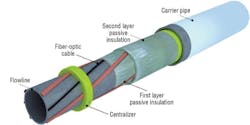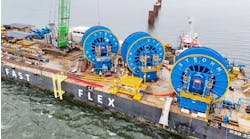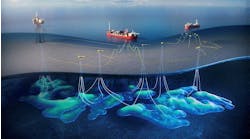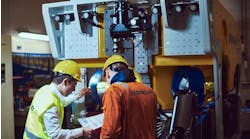Raphael Moscarello
Vlad Popovici
ShawCor
Subsea production systems confront increasingly challenging temperature and pressure conditions, so it is important to assess the long-term insulation performance through various methods such as simulated service testing. Simulated service testing, where a thermally insulated pipe is exposed to the water pressure and temperature it will see in deepwater service, typically is used to collect data and to simulate long-term performance of an insulation system.
ShawCor’s simulated service vessel (SSV) simulates service conditions by applying pressure to water surrounding the system while controlling the temperature inside the pipe. Continuous water flow ensures a stable, chilled water temperature on the outside of the pipe. The SSV can test insulated components of subsea production systems: linepipe, field joints, flexible pipe, or other custom fabricated parts such as flanges and fittings. It can also simulate service conditions for both multilayer and injection-molded insulation systems.
Measurement precision
The precise measurement capabilities and capacity of the vessel allow detailed characterization of performance and accurate real-time measurement of heat flux, thermal conductivity, and U-value.
The combination of SSV test data, laboratory material testing, and analytical methods establishs reliable predictors of long-term performance. This is important to reduce overall project risk in deep, subsea environments, and allows operators to implement a holistic, end-to-end thermal insulation approach by assessing the performance of entire subsea piping systems, not only linepipe, but also field joints and custom fabricated parts.
To ensure the continuous flow of hydrocarbon fluid through subsea oil and gas pipelines, thermal insulation coating often is applied to the piping systems to maintain the operating temperature of the conduit. Thermal insulation is also used to extend cool down time by controlling energy loss during planned or unplanned shut downs. To reduce the risk of sub optimal performance and to design systems with lasting reliability, it is important to accurately quantify the long-term performance of the insulated subsea production systems. The high-pressure/high-temperature trend also encourages development of innovative thermal insulation materials and systems that need to be thoroughly tested and qualified for use.
By measuring the changes in heat flow, thermal conductivity, and compressive creep of the insulation system, both the long-term thermal efficiency and depth rating capabilities of the insulation can be confirmed along with the overall heat transfer coefficient (U-value).
Testing capabilities
To accommodate market trends towards deepwater oil and gas production, the SSV was designed for rigorous testing down to water depths of 3,000 m (300 bar), external temperatures of 4 °C (40 °F) and internal temperatures up to 180 °C (356 °F). The vessel captures precise measurements for accurate U-value calculations that then can be used to model and design the insulation system.
The SSV accommodates project specific pipe – with internal diameter (ID) of up to 800 mm (32 in.) – that will be put into service so the operator will know accurately the true representative thermal performance of the installed pipe, custom fitting, or field joint. In addition, the SSV can test and compare three insulation coatings simultaneously, thereby shortening the test period.
SSV measurement and control system.
Further tests such as triaxial creep and finite element analysis (FEA) modeling of the insulation can run in parallel with the SSV tests to establish reliable, predictors of the long term performance of the insulation to minimize project risk.
An SSV fundamentally is a large, cylindrical autoclave which can accommodate an insulated pipe or structure. The design of the vessel and test procedure follows the highest safety standards. The vessel door, which weighs 20 metric tons (22 tons), is fully supported on a cart at all times during operation. The pipe is supported on a carriage during both set up and testing, eliminating the hazards of a suspended load.
Instrumentation system
To begin a test, a thermally insulated pipe is mounted in the vessel which is instrumented with displacement transducers to measure diametrical change under hydrostatic load, thermal sensors for temperature measurement, and heat flux sensors to determine the heat loss from the system. Once thermal equilibrium is established, the vessel is pressurized and held at the required pressure for the duration of the test. The pressure is increased in specific increments to assess the immediate and long-term response of insulation properties to changes in pressure at a specific operating temperature.
To obtain the desired test data, the measurement and control system of the SSV has several features. The steel pipe is heated with a seven-zone electrical heater and controlled by thermocouples in each zone. The following parameters are monitored:
- Water temperature
- Pressure
- Temperature of the insulation coating surface
- Heat flux in the radial direction at different zones
- Radial displacement using LVDT sensors
- Power consumption in each zone.
Heat flow is measured directly by sensors mounted on the pipe to provide real time, accurate measurements along the length of the pipe. The heating system provides precise temperature control with a high capacity chiller and circulating pump, to maintain a water temperature of 4- 6°C (40-43°F). The system continuously monitors and records thermal properties during the test. The multi-zone controls and multi-point measurements of this system record the insulation coating performance under the defined test conditions.
Determining thermal properties
The SSV test provides accurate, real-time measurements and records compressive creep, heat flux, and thermal conductivity of multi-layer thermal insulation systems. Based on precise inputs, reliable U-values of the system can be calculated along various points on the pipe.
“Creep” is mechanical deformation of the insulation system resulting from the combined effects of time, temperature, and mechanical load. Combined, these factors can be detrimental to long-term thermal properties, and thus affect the flow of fluid through the pipe. Creep can be measured in a triaxial creep test, which determines the specific material dependant deformation as a function of time, temperature, and pressure.
However, these samples are not fully representative of insulation systems coated on pipe. The compressive creep curves generated by the SSV are important for computer modeling and thermal design of solid, foamed, and syntactic insulation systems. During the SSV test, the increase in pressure is planned in steps to capture the response of the system to pressure changes. The typical response for foam is to compresses over time. For a solid polymer, the material shows an immediate response that plateaus after about one week.
Predicting performance
The best estimate of thermal performance is to compare FEA models with the actual performance of a project pipe from an SSV test. From laboratory test data, an FEA model can be generated to predict thermal and mechanical insulation properties. Triaxial creep tests can be used to further improve the FEA model. Consideration of the pipe-to-pipe variance is established using process capability studies and quality control (QC) data gathered during production. This pipe-to-pipe variance, combined with the deviations between FEA predicted results and SSV test data, establishes confidence intervals around the thermal performance of pipes manufactured under the specified production conditions. The determination of confidence intervals should lead to a more accurate prediction of the long-term performance of the insulation system.
Acknowledgments
Based on a paper presented at the ASME International Offshore Pipeline Forum & Exhibition held Oct. 20-21, 2010, in Houston.
Offshore Articles Archives
View Oil and Gas Articles on PennEnergy.com





